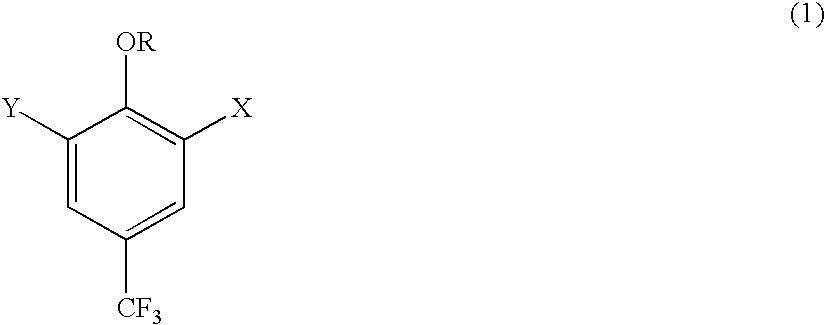Derivatives of 4-(trifluoromethyl)-phenol and 4-(trifluoromethylphenyl)-2-(tetrahydropyranyl) ether and method for producing the same
a technology of trifluoroacetic acid and derivatives, which is applied in the field of derivatives of 4(trifluoromethyl)phenol and 4(trifluoromethylphenyl)2(tetrahydropyranyl) ether and method for producing the same, can solve the disadvantages of corrosive and toxic trifluoroacetic acid and the chromatographic purification necessary, and the chromatographic purification of the product is necessary, and the use of toxi
- Summary
- Abstract
- Description
- Claims
- Application Information
AI Technical Summary
Benefits of technology
Problems solved by technology
Method used
Image
Examples
example 1
[0082] Preparation of 1-[2-(tetrahydro-2H-pyran-2-yloxy)-5-(trifluoro-meth-yl) phenyl]-1-propanone (R=2-tetrahydropyranyl, X =C.sub.2H.sub.5CO, Y =H).
[0083] 24 g (0.207 mol) of tetramethylethylenediamine are introduced at -10.degree. C. and 130 ml of butyllithium in hexane (1.63 molar, 0.212 mol) are added dropwise in about 30 min. After 15 min. the melt of 40 g (GC 90%, 0.146 mol) of 4-(trifluoromethyl)phenyl 2-tetrahydropyranyl ether is added dropwise at -10.degree. C. in the course of 30 min. The lithium complex precipitates in the course of this. After 1 hour, 24 g (0.205 mol) of propionic acid N-methoxy-N-methylamide are added. A turbid solution results, which is added dropwise after 1 hour to 60 ml of 32% strength hydrochloric acid in 40 ml of water. The aqueous phase is separated off and extracted with hexane and the organic phases are concentrated. The residue is recrystallized from hexane at -50.degree. C. 27.3 g (HPLC 96%, 91 mmol, yield 62.3%) of 1-[2-(tetrahydro-2H-pyran...
example 2
[0084] Preparation of 2-hydroxy-5-(trifluoromethyl)benzaldehyde (R =H, X =CHO, Y =H)
[0085] 241 g (2.08 mol) of tetramethylethylenediamine are introduced at -10.degree. C. and 1.3 1 of butyllithium in hexane (1.63 molar, 2.12 mol) are added dropwise in about 30 min. After 45 min. the melt of 400 g (GC 92%, 1.5 mol) of 4-(trifluoromethyl)phenyl
[0086] 2-tetrahydropyranyl ether is added dropwise at -10.degree. C. in the course of 30 min. The lithium complex precipitates in the course of this. After 2 hours, 152 g (2.08 mol) of dimethylformamide (DMF) are added dropwise. A turbid solution results which is added dropwise at not more than 45.degree. C. after 15 min. to 750 ml of 38% strength hydrochloric acid in 500 ml of water in the course of 30 min. A strong evolution of gas results. The mixture is stirred overnight, the aqueous phase is separated off, and the organic phase is treated with 70 ml of 4 M dioxane / HCl solution and again stirred overnight. The product is crystallized by cool...
example 3
[0087] Preparation of trimethyl[2-(tetrahydro-2H-pyran-2-yloxy)-5-(trifluo-romethyl)phenyl]silane (R =2-tetrahydropyranyl, Y =H; X =SiMe.sub.3).
[0088] 2.9 g (25 mmol) of tetramethylethylenediamine and 15.9 ml (15% strength, 26 mmol) of butyllithium in hexane are introduced at -20.degree. C. and 5 g (HPLC: 98%, 19.9 mmol) of 4-(trifluoromethyl)pheny-l 2-tetrahydropyranyl ether dissolved in 10 ml of tetrahydrofuran (THF) are added dropwise. After 30 minutes, 2.63 g (24 mmol) of chlorotrimethylsilane and, after 2 hours, 5 ml of water are added. The reaction mixture is allowed to warm to 20.degree. C., the phases are separated, the organic phase is washed once with saturated sodium chloride solution and the combined aqueous phases are washed three times with 5 ml of methyl t-butyl ether each time. The organic phases are combined, dried over sodium sulfate and concentrated in vacuo. The residue is purified by column chromatography (silica gel, petroleum ether / methyl t-butyl ether =5:1). ...
PUM
| Property | Measurement | Unit |
|---|---|---|
| Length | aaaaa | aaaaa |
| Pressure | aaaaa | aaaaa |
| Angle | aaaaa | aaaaa |
Abstract
Description
Claims
Application Information
 Login to View More
Login to View More - R&D
- Intellectual Property
- Life Sciences
- Materials
- Tech Scout
- Unparalleled Data Quality
- Higher Quality Content
- 60% Fewer Hallucinations
Browse by: Latest US Patents, China's latest patents, Technical Efficacy Thesaurus, Application Domain, Technology Topic, Popular Technical Reports.
© 2025 PatSnap. All rights reserved.Legal|Privacy policy|Modern Slavery Act Transparency Statement|Sitemap|About US| Contact US: help@patsnap.com



